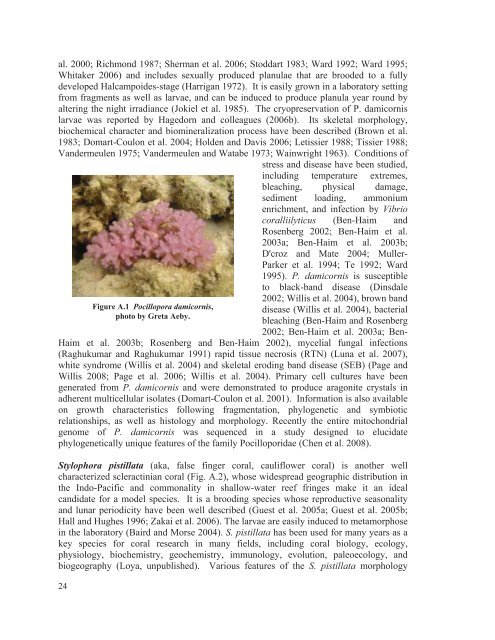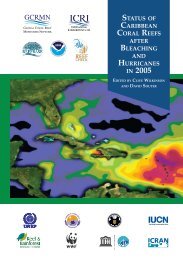Coral Health and Disease in the Pacific: Vision for Action
Coral Health and Disease in the Pacific: Vision for Action
Coral Health and Disease in the Pacific: Vision for Action
Create successful ePaper yourself
Turn your PDF publications into a flip-book with our unique Google optimized e-Paper software.
al. 2000; Richmond 1987; Sherman et al. 2006; Stoddart 1983; Ward 1992; Ward 1995;Whitaker 2006) <strong>and</strong> <strong>in</strong>cludes sexually produced planulae that are brooded to a fullydeveloped Halcampoides-stage (Harrigan 1972). It is easily grown <strong>in</strong> a laboratory sett<strong>in</strong>gfrom fragments as well as larvae, <strong>and</strong> can be <strong>in</strong>duced to produce planula year round byalter<strong>in</strong>g <strong>the</strong> night irradiance (Jokiel et al. 1985). The cryopreservation of P. damicornislarvae was reported by Hagedorn <strong>and</strong> colleagues (2006b). Its skeletal morphology,biochemical character <strong>and</strong> biom<strong>in</strong>eralization process have been described (Brown et al.1983; Domart-Coulon et al. 2004; Holden <strong>and</strong> Davis 2006; Letissier 1988; Tissier 1988;V<strong>and</strong>ermeulen 1975; V<strong>and</strong>ermeulen <strong>and</strong> Watabe 1973; Wa<strong>in</strong>wright 1963). Conditions ofstress <strong>and</strong> disease have been studied,<strong>in</strong>clud<strong>in</strong>g temperature extremes,bleach<strong>in</strong>g, physical damage,sediment load<strong>in</strong>g, ammoniumenrichment, <strong>and</strong> <strong>in</strong>fection by Vibriocoralliilyticus (Ben-Haim <strong>and</strong>Rosenberg 2002; Ben-Haim et al.2003a; Ben-Haim et al. 2003b;D'croz <strong>and</strong> Mate 2004; Muller-Parker et al. 1994; Te 1992; Ward1995). P. damicornis is susceptibleto black-b<strong>and</strong> disease (D<strong>in</strong>sdale24Figure A.1 Pocillopora damicornis,photo by Greta Aeby.2002; Willis et al. 2004), brown b<strong>and</strong>disease (Willis et al. 2004), bacterialbleach<strong>in</strong>g (Ben-Haim <strong>and</strong> Rosenberg2002; Ben-Haim et al. 2003a; Ben-Haim et al. 2003b; Rosenberg <strong>and</strong> Ben-Haim 2002), mycelial fungal <strong>in</strong>fections(Raghukumar <strong>and</strong> Raghukumar 1991) rapid tissue necrosis (RTN) (Luna et al. 2007),white syndrome (Willis et al. 2004) <strong>and</strong> skeletal erod<strong>in</strong>g b<strong>and</strong> disease (SEB) (Page <strong>and</strong>Willis 2008; Page et al. 2006; Willis et al. 2004). Primary cell cultures have beengenerated from P. damicornis <strong>and</strong> were demonstrated to produce aragonite crystals <strong>in</strong>adherent multicellular isolates (Domart-Coulon et al. 2001). In<strong>for</strong>mation is also availableon growth characteristics follow<strong>in</strong>g fragmentation, phylogenetic <strong>and</strong> symbioticrelationships, as well as histology <strong>and</strong> morphology. Recently <strong>the</strong> entire mitochondrialgenome of P. damicornis was sequenced <strong>in</strong> a study designed to elucidatephylogenetically unique features of <strong>the</strong> family Pocilloporidae (Chen et al. 2008).Stylophora pistillata (aka, false f<strong>in</strong>ger coral, cauliflower coral) is ano<strong>the</strong>r wellcharacterized scleract<strong>in</strong>ian coral (Fig. A.2), whose widespread geographic distribution <strong>in</strong><strong>the</strong> Indo-<strong>Pacific</strong> <strong>and</strong> commonality <strong>in</strong> shallow-water reef fr<strong>in</strong>ges make it an idealc<strong>and</strong>idate <strong>for</strong> a model species. It is a brood<strong>in</strong>g species whose reproductive seasonality<strong>and</strong> lunar periodicity have been well described (Guest et al. 2005a; Guest et al. 2005b;Hall <strong>and</strong> Hughes 1996; Zakai et al. 2006). The larvae are easily <strong>in</strong>duced to metamorphose<strong>in</strong> <strong>the</strong> laboratory (Baird <strong>and</strong> Morse 2004). S. pistillata has been used <strong>for</strong> many years as akey species <strong>for</strong> coral research <strong>in</strong> many fields, <strong>in</strong>clud<strong>in</strong>g coral biology, ecology,physiology, biochemistry, geochemistry, immunology, evolution, paleoecology, <strong>and</strong>biogeography (Loya, unpublished). Various features of <strong>the</strong> S. pistillata morphology
















